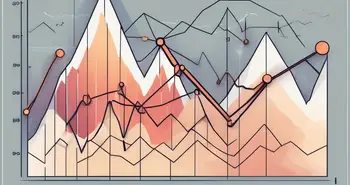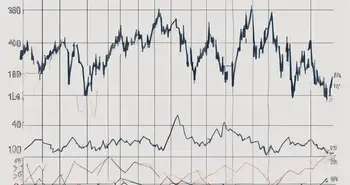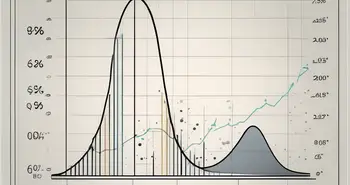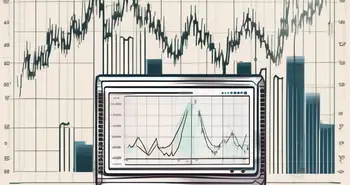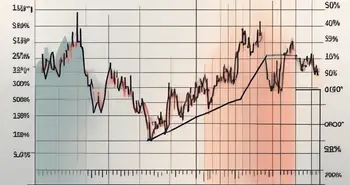The Ultimate Guide to the KST Indicator: How to Use and Interpret
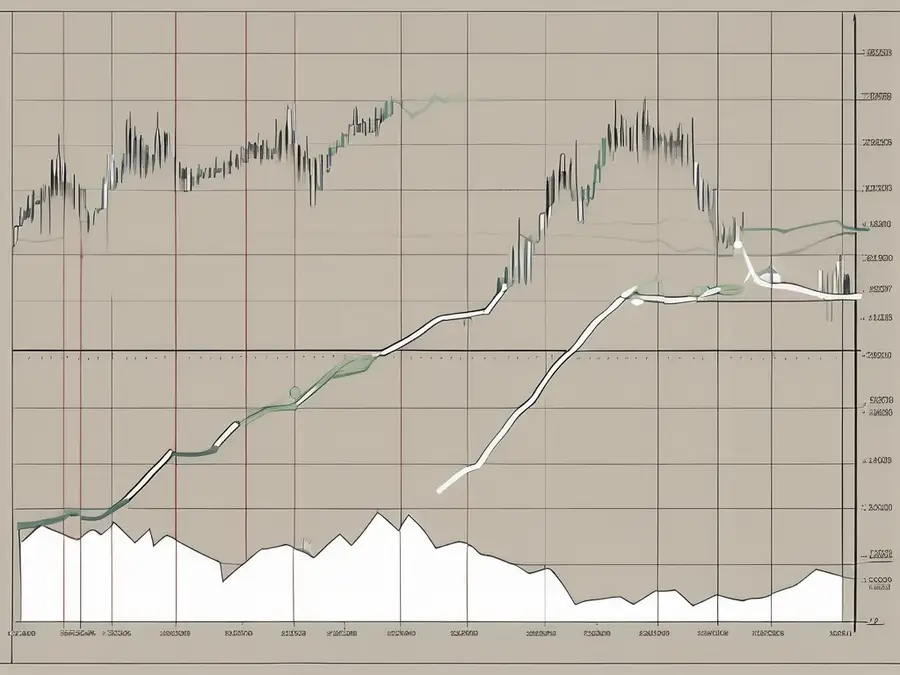
Hey there! Welcome to “The Ultimate Guide to the KST Indicator: How to Use and Interpret”. I'm thrilled to be your expert guide on this journey. So, let's dive right in!
Understanding the Basics of KST Indicator
Before we start exploring the KST Indicator, let's first understand what it actually is. The KST Indicator, short for Know Sure Thing Indicator, is a powerful tool used by traders and investors to analyze market trends and momentum. Developed by Martin Pring, this indicator uses four different timeframes and various weighted moving averages to generate accurate trading signals.
But why is the KST Indicator so popular among traders? Well, it's because this indicator has proven its reliability time and time again in identifying potential market reversals and trend changes. Its unique approach in combining different timeframes provides a comprehensive view of market conditions, making it an invaluable asset for traders.
Now, let's take a closer look at the mathematics behind the KST Indicator. Don't worry; it's not as intimidating as it sounds!
What is the KST Indicator?
The KST Indicator is a momentum oscillator that measures the rate of change of an asset's price over multiple timeframes. By using a series of exponential moving averages (EMAs), the KST Indicator smoothes out the price data and reveals the underlying trends hidden within the market noise. This helps traders identify potential entry and exit points.
The Mathematics Behind the KST Indicator
Let's take a quick detour into the realm of numbers. The KST Indicator calculates its value by combining four different EMAs. Each EMA represents a different timeframe, with longer-term EMAs contributing more weight to the final calculation. By using different timeframes, the KST Indicator captures both short-term price movements and long-term trends.
Once the EMAs are calculated, they are then plotted on a chart, usually with a trigger line. When the KST line crosses above the trigger line, it's a bullish signal, suggesting the start of an upward trend. Conversely, when the KST line crosses below the trigger line, it's a bearish signal, indicating a potential downtrend.
The Importance of the KST Indicator in Trading
Now that you understand the basics of the KST Indicator, let's explore its significance in trading. The KST Indicator plays a crucial role in identifying market trends and providing valuable insights into potential trading opportunities. Let's delve into two key aspects of the KST Indicator's importance: its role in identifying market trends and its impact on risk management.
Role of KST Indicator in Identifying Market Trends
One of the primary uses of the KST Indicator is to identify market trends accurately. By analyzing the KST line and its crossovers with the trigger line, traders can spot potential trend reversals and confirm existing trends. This information allows traders to make informed decisions to enter or exit trades, increasing the likelihood of capturing profitable opportunities.
For example, let's say you're a swing trader monitoring a stock's price movements. By using the KST Indicator, you can identify when a downtrend may be transitioning into an uptrend. This knowledge empowers you to enter the market at an optimal time, maximizing your potential profits.
KST Indicator and Risk Management
Risk management is a crucial aspect of any successful trading strategy. That's where the KST Indicator shines. By providing reliable signals of potential trend reversals, the KST Indicator helps traders manage their risk effectively. It allows traders to set stop-loss orders or exit positions when the market conditions suggest an unfavorable trend change.
Here's a piece of expert advice: always combine the KST Indicator with other technical analysis tools to enhance its effectiveness. Utilizing tools like support and resistance levels, trendlines, or candlestick patterns alongside the KST Indicator can provide a more comprehensive picture of the market and improve decision-making.
How to Use the KST Indicator
Now that we've covered the basics and explored the importance of the KST Indicator, let's move on to learning how to use this powerful tool in your trading endeavors. Here are two essential steps: setting up the KST Indicator and interpreting its signals.
Setting Up the KST Indicator
To set up the KST Indicator on your trading platform, follow these simple steps:
- Open your preferred trading platform and navigate to the indicator menu.
- Locate the KST Indicator and click on it.
- Adjust the indicator's parameters, such as the timeframes and weightings, to suit your trading style and preferences.
- Apply the KST Indicator to your chart, and voila! You're ready to dive into its insightful analysis.
Interpreting the KST Indicator Signals
Interpreting the KST Indicator signals correctly is vital for successful trading. Here are a few key points to consider when analyzing the KST Indicator:
- Focus on the KST line crossing above or below the trigger line. This can indicate potential buy (above) or sell (below) signals.
- Pay attention to the slope and steepness of the KST line. A steeper slope indicates stronger momentum.
- Combine the KST Indicator signals with other confirmation indicators or chart patterns to increase confidence in your trading decisions.
Advanced Techniques in Using the KST Indicator
Now that you've grasped the essential steps, let's take your understanding of the KST Indicator to the next level! By combining the KST Indicator with other trading tools and avoiding common pitfalls, you can achieve even better results.
Combining KST Indicator with Other Trading Tools
Remember that expert advice I mentioned earlier? Well, it's time to bring it back into the spotlight! Combining the KST Indicator with other technical analysis tools can elevate your trading game. For example, you can use the KST Indicator alongside moving averages or trendlines to confirm potential trend reversals or breakout opportunities.
Additionally, incorporating volume indicators or oscillators, such as the Relative Strength Index (RSI), into your analysis can further strengthen your trading strategy when used in conjunction with the KST Indicator.
Avoiding Common Mistakes in Using the KST Indicator
Even experienced traders can fall into the trap of making common mistakes when using the KST Indicator. Here are a couple of pitfalls to watch out for:
- Avoid relying solely on the KST Indicator for your trading decisions. Instead, use it as a complementary tool alongside other technical indicators.
- Don't overlook the importance of risk management. The KST Indicator can provide valuable insights, but it's crucial to implement proper risk management strategies and adhere to your trading plan.
The Limitations of the KST Indicator
While the KST Indicator is a valuable tool, it's essential to acknowledge its limitations. Understanding these limitations can help you make more informed decisions and avoid potential pitfalls.
When the KST Indicator May Not Work
Like any technical indicator, the KST Indicator may not work effectively in all market conditions. It performs best in trending markets but can produce false signals or whipsaws during periods of low volatility or choppy price action. During such times, it's crucial to use additional confirmation indicators or exercise caution when relying solely on the KST Indicator.
Overcoming the Limitations of the KST Indicator
Overcoming the limitations of the KST Indicator is all about adaptability. Consider experimenting with different parameter settings or combining the KST Indicator with other complementary tools to improve its accuracy. Additionally, staying updated with market news, events, and qualitative analysis can provide valuable context to your trading decisions and overcome the limitations of any technical indicator.
FAQs – Let's Recap!
Q: What is the KST Indicator?
A: The KST Indicator is a momentum oscillator that combines four different timeframes and moving averages to provide insights into market trends and potential trading signals.
Q: How do I set up the KST Indicator?
A: Simply navigate to your trading platform's indicator menu, find the KST Indicator, adjust the parameters to your liking, and apply it to your chart.
Q: How do I interpret the KST Indicator signals?
A: Pay attention to the KST line crossing above or below the trigger line, the slope of the KST line, and confirm the signals with other technical analysis tools for increased confidence.
Q: Can I solely rely on the KST Indicator for my trading decisions?
A: It's highly recommended to complement the KST Indicator with other technical analysis tools and incorporate proper risk management strategies to ensure successful trading.
And there you have it! You're now equipped with “The Ultimate Guide to the KST Indicator: How to Use and Interpret.” Wishing you successful trading endeavors with the KST Indicator in your arsenal!
Ready to put the KST Indicator into action? Join Morpher today and experience a revolutionary trading platform that harnesses blockchain technology to elevate your trading strategy. With zero fees, infinite liquidity, and the ability to trade a wide array of assets, Morpher is the perfect place to apply your new knowledge of the KST Indicator. Whether you're looking to invest fractionally, short sell, or leverage your trades, Morpher offers a unique and flexible trading experience. Sign up now at Morpher.com and receive your free sign-up bonus to start trading like a pro!

Disclaimer: All investments involve risk, and the past performance of a security, industry, sector, market, financial product, trading strategy, or individual’s trading does not guarantee future results or returns. Investors are fully responsible for any investment decisions they make. Such decisions should be based solely on an evaluation of their financial circumstances, investment objectives, risk tolerance, and liquidity needs. This post does not constitute investment advice.

Painless trading for everyone
Hundreds of markets all in one place - Apple, Bitcoin, Gold, Watches, NFTs, Sneakers and so much more.

Painless trading for everyone
Hundreds of markets all in one place - Apple, Bitcoin, Gold, Watches, NFTs, Sneakers and so much more.

